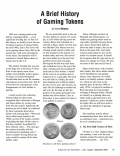You have probably already seen this if you have the 2nd Edition of Seymour's book, but he dates the inlaid square edge clay chips as showing up in catalogs beginning in the 1890s. They were paranoids made by the USPC Co.
Something interesting I just noticed looking at that advertisement. It touts "... solid colors that extend through the entire chip". At first, that seems like an odd thing to boast about - that's true of
all the chips we normally think about from that period (or ever after, for that matter). They're molded from one sort of plastic or another, and the plastic is dyed throughout when it's manufactured, well before it gets put in a mold.
But then I realized:
ivory chips are dyed
on the surface.
I only know this because of the ivory chips I got from the Eisenstadt estate and had a chance to see up close. This isn't one of them, but here's an example I found online:
Looking at my own chips, I discovered that a chip like this was made by first cutting the ivory stock into blank chips (probably by lathing it into a cylinder and then slicing it into discs), then
dyeing the chips. The dye did not penetrate the surface very far; you can see where this chip was worn somewhat on the lower edge and consequently became lighter. Once the chip was uniformly colored, the center area was then
milled, creating a very slight recess which exposed the bare uncolored ivory. Then the floral design was etched (by hand!) into the recess.
If you look closely at the picture (you might need to magnify it) you can see the circular mill marks in the recess. They're
different from and
in addition to the natural rings of the ivory which circle around the nerve hole, which is off-center. The mill marks are perfectly concentric.
A lot of the ivory chips I've seen in pictures aren't dyed at all... but many of them are, and of those that are dyed, they seem to be of a similar construction - a colored outer ring and a bare ivory center. I'll bet in all of them the center is a shallow milled recess. That's true in all of mine, and I have at least three examples from unrelated sets of chips.
The point being - if clay composition chips were being sold as substitutes for ivory chips, the chipmakers might have wanted to point out that they're colored all the way through to
distinguish them from ivories and make them seem
better.


